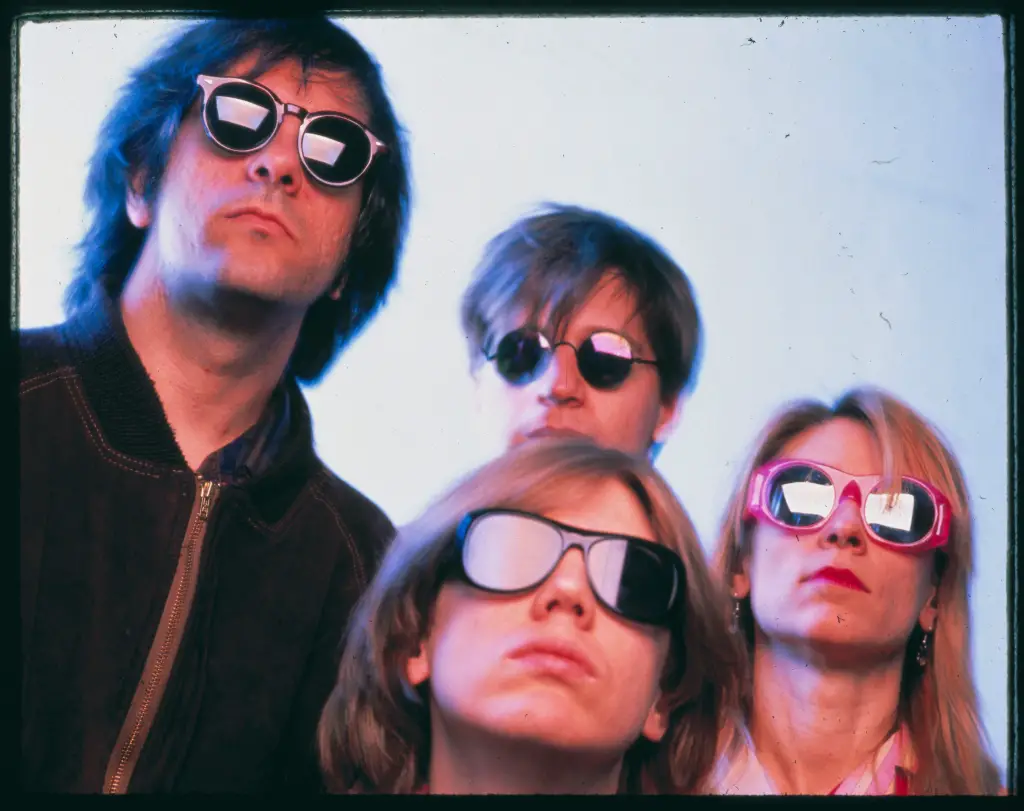All images courtesy of Getty Images/Sonic Youth Facebook (official)
Goo is Sonic Youth’s sixth album and their major-label debut after almost a decade of putting albums out on indie labels such as SST, Glenn Branca’s Neutral Records, Homestead, and Enigma Records. Sonic Youth, at its core, was Thurston Moore, Kim Gordon, Steve Shelley, and Lee Ranaldo. Although, there were also a series of random drummers prior to the band hiring Shelley. There have been other members as well at times especially in later years when they expanded to beyond a four-piece and had people such as Mark Ibold (of Pavement), and Jim O’Rourke (of Gastr Del Sol).
Sonic Youth was prominent in the No Wave art and music scene of the 80s and gradually built a large underground following with such albums as Confusion Is Sex (1983), Bad Moon Rising (1985), EVOL(1986), Sister (1987, and Daydream Nation (1988). Daydream Nation gave the band much more mainstream, attention, and the single “Teenage Riot” got airplay on college rock and modern rock radio. Unfortunately, due to distribution problems, the album was often hard to find in stores. This led to them seeking a major label deal, signing with Geffen Records, and Daydream Nation being re-released under the DGC label. The first album of this deal was Goo.

The album was released in June of 1990. The lead single, “Kool Thing,” was released the same month. The songs “Disappearer,” and “Dirty Boots” were also released as singles from Goo. The songs on the album were more accessible than previous efforts, but mostly they took previously used ideas, and styles, and expanded upon them. The album cover, featuring a drawing of two sunglasses-wearing British mods, was done by Raymond Pettibon who was responsible for many of Black Flag’s album covers.
The record kicks of with the third single “Dirty Boots,” which starts with mid-tempo guitar, and singing which continues for the first half of the song, until it kicks into another gear with heavier guitar, and a big chorus. The song then slows down for the ending — an epic song, in my opinion.
Next up we have “Tunic(Song for Karen),” which is a song about Karen Carpenter, and her battle with Anorexia nervosa. Even to the point of mentioning her mother would tell her that she, “looked so underfed.” Kim Gordon sings at one point, “I feel like I am disappearing, getting smaller every day, but when I open my mouth to sing, I am bigger in every way.” The song addresses both self-esteem, and body image in a very relatable way, as this is a celebrity we knew who had these issues that many people deal with. Personally, I love the guitar tone and chord progressions in this song.
“Mary Christ” is next and this is a straight-ahead Sonic Youth rocker. After that, we have “Kool Thing,” which was inspired by Kim Gordons interview with LL Cool J that left her disillusioned due to his misogyny, and ignorance of Punk Rock in general. She used the experience to write the song, and the lyric, “walking like a panther” is most likely a reference to LL Cool J’s album Walking With A Panther. Chuck D, of Public Enemy, guests on the song for the back, and fourth section of the song.
Other highlights are “My Friend Goo” which kicks off side two, and is the basis for the album title (originally, the album was titled Blowjob). A full-on Rock song, short and to the point. Then we have “Disappearer,” the second single. “Mildred Pierce” follows, and is mostly instrumental, with the exception of the title being spoken, and the track ending with screaming. The title came from the classic film noir of the same name. Lastly, “Cinderellas Big Score,” “Scooter And Jinx,” and “Titanium Expose” round out the remainder of the Goo.

Sonic Youth signing with Geffen Records is also an important point in Rock and music history as they encouraged Geffen to sign Nirvana. That, of course, led to mainstream success for many other bands as well. Indie bands could now get major label deals, and record labels were now seeking this type of music out. Grunge and the Seattle scene soon became a “thing.”
I had the pleasure of seeing Sonic Youth three times. The first show was on the Beastie Boys Check Your Head tour when Sonic Youth was touring for Dirty. A great show where at one point, Thurston Moore put a drumstick between guitar strings to create more noise, and distortion than usual.
The next time I saw Sonic Youth was opening for R.E.M. on the Monster tour. They played “Tom Violence” off of EVOL as the first song. This was an arena tour, and R.E.M. was pretty huge at the time, so I am not sure that any of the crowd were familiar with Sonic Youth. Regardless, they played a short but good set.
The final show I saw was at Lollapalooza, in 1995. This was the show the night after Courtney Love had allegedly punched Kathleen Hanna of Bikini Kill in the face. She had her arm in a sling that night. Sonic Youth’s set was great, and it was a pretty great lineup overall.
Sonic Youth broke up in 2011, although it was unofficial until a few years later. This was the same year that Thurston Moore and Kim Gordon separated. The members of the band have continued to produce both music, and art, and Kim Gordon had a book out, in 2015, called Girl In A Band. It’s quite a good read.
As for Sonic Youth, Goo was a turning point in the band’s history and affected the direction of music that followed it for them, and others.
Please check out my video on Goo, by Sonic Youth below:
Dig this article? Check out the full archives of Surface Noise, by John Siden, here: https://vinylwritermusic.wordpress.com/surface-noise-archives/





Leave a Reply